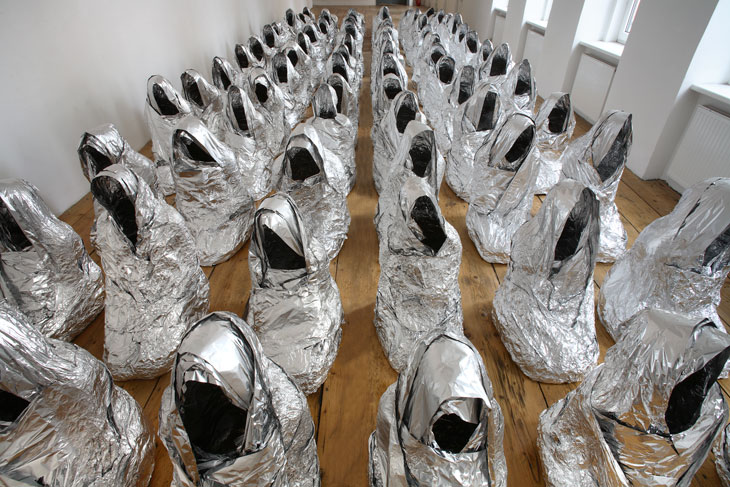Click HERE to have your say about this article – at SEESMIC video discussion
We enjoyed immensly our visit to Unveiled: New art from the middle-east at London’s Saatchi Gallery. This ‘review’ is about Ghost by Kader Attia – and how it is great work – including for teachers or home-schoolers. (Exhibition ends 9th May 2009)

Kader Attia – Ghost – 2007 – Aluminium foil – Dimensions variable – Saatchi Gallery, London
In Ghost, a large installation of a group of Muslim women in prayer, Attia renders their bodies as vacant shells, empty hoods devoid of personhood or spirit. Made from tin foil – a domestic, throw away material – Attia’s figures become alien and futuristic, synthesising the abject and divine. Bowing in shimmering meditation, their ritual is equally seductive and hollow, questioning modern ideologies – from religion to nationalism and consumerism – in relation to individual identity, social perception, devotion and exclusion. Attia’s Ghost evokes contemplation of the human condition as vulnerable and mortal; his impoverished materials suggest alternative histories or understandings of the world, manifest in individual and temporal experience. (This is the gallery description)
-0-
Draft Notes for suggested lessons:
I always admire simplicity – creating a profound piece just by wrapping aluminium foil around a room full of kneeling women – great simplicity.
Presence and absence – traces – how and it what ways do people live on.
Why might the artist have called the piece Ghost as opposed to Ghosts? Which do you prefer and why?
What makes a person a person?
Which bits of the gallery description of Ghost make good sense to you – and which don’t – and why?
Two of the most important concerns in a person’s development are 1) identity – who am I? and 2) purpose – what am I dedicating my life to? What has Ghost to do with identity and purpose?
How powerful might it be if, as a performance piece, a real live woman came and filled one of the places? Would you dress her in aluminium or not – how else would you dress her? Would she speak to the audience? What would she say?
The aluminium creates boundaries, forms – of people who were/are/aren’t no more. Is there spirit to go with the form – or not? If so what is it – where is it – whose spirit is it?
What are your feelings about the women whose forms gave rise to the ghost/s?
How might a fundamentalist respond to this piece? How might a modern believer respond to this piece?
Create a conversation betwen two such people.
What would the whole thing be like if the women had been from Christian/Jewish/Hindu/Buddhist etc background?
What conclusions do you come to as a result of viewing the photograph – or better still having visited the exhibition?
How would you use your/the above ideas to make your own art?


I like it a lot; it’s a great piece of work.
LikeLike
like the questions? did anyone answer them?
LikeLike
I live in hope!
I’ve yet to find a group with whom to use this work of art.
If you teach try it with a class and let me know!
Thanks for your reply
Roger
LikeLike
Am a muslim myslef and love Art but this artist i’v come across accidently. I just wanted to find out what this art work meant, i did like the work but when i found out its about muslim women praying just thought it was abit offensive of why he would call it ‘Ghost.’ Is he trying to make a judgement about muslim women? I just feel abit upset as he also did another work and called it couscous kabab…if hes trying to take the mick out if muslims praying and the religion, then shame on him…
LikeLike